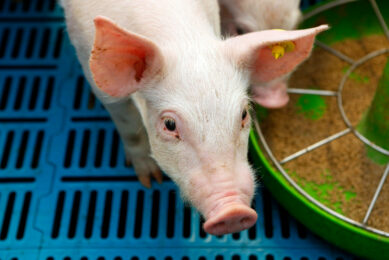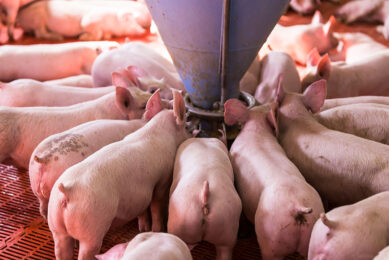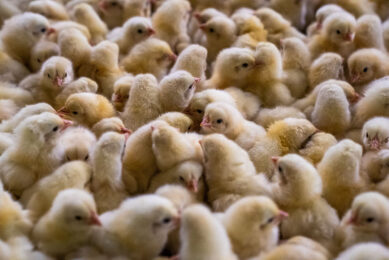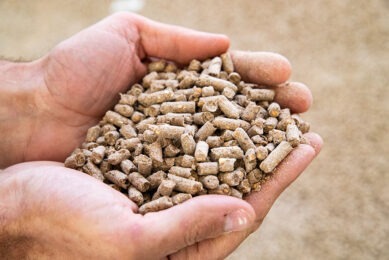The way forward with organic acids
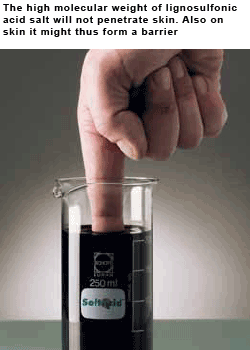
Organic acids have gained worldwide acceptance as the choice replacement for antibiotic growth promoters (AGPs) in livestock feed. This is due to their ability to kill pathogenic microorganisms that cause disease and deter the growth performance of livestock. Negative effects in handling and use of regular organic acids have now been minimised with new technology.
By Mathieu Calmont and Justin Y. W. Tan, Borregaard LignoTech, Norway
As antimicrobial agents, organic acids function in two distinct ways. The more commonly known mode of action of acidifiers is via pH depression by the release of protons to surrounding media, creating undesirable or unfavourable conditions for pathogens.
The other less known mode of action is its ability to change from a non-dissociated form to a dissociated form, depending on the pH of its surrounding environment. When an acid is in its non-dissociated form, it can diffuse freely across the semi-permeable surface of microorganisms, penetrating through the cell wall into the cell cytoplasm. Once within the cell, the acid undergoes the dissociation process, releasing protons that cause the internal pH of the cell to drop. As the normal pH of the cell is usually close to pH 7, this drop in pH will suppress cell enzymes and nutrient transport systems, causing metabolic disturbances within the cell, finally killing the pathogen. Unbeknownst to many, the latter mode of action is of far higher significance compared to the former in terms of antimicrobial efficacy.
It is also a myth and a misconception that organic acids have any benefits in the intestines of livestock. It has been proven that organic acids work primarily in the stomach of livestock animals, where the pH is lower than the pKa of the acid, as the intestinal tract is much too alkaline for any reduction in pH to be significant or beneficial. To comprehend this completely, one must be able to fully understand the relationship between the pKaof an acid and its surrounding pH.
Organic acids: the predicament
The antimicrobial activity of organic acids enables such additives to be widely used in the preservation of livestock feed, silages, cereals and grains. Organic acids are known to be effective both in reducing bacterial contamination as well as preventing mould growth in livestock feedstuffs.
However, despite its proven effects and benefits as an antimicrobial agent, the use of acidifiers in animal feed remains limited. This is mainly due to its detrimental properties:
- Corrosiveness – Pure organic acids cause serious damage to equipment and work areas, and thorough cleaning needs to be undertaken after its use. Protective gear is required.
- Volatility – A large quantity is also often lost through evaporation, where 15-20% is known to be lost during the process of pelleting.
- Odour – Organic acids tend to have very strong odour, making working environments unpleasant for all involved in its handling.
Drawbacks of buffered and coated acids
Once added to feedstuffs, organic acids often cause a decrease in animal feed consumption. This has led to the acceptance of what is known as buffered organic acids. These are organic acids that are combined with alkaline agents such as calcium or ammonia to form a salt complex such as calcium formate and ammonium propionate. While this effectively reduces the corrosivity of pure organic acids, the corrosive nature of buffered acids is still inherent, even if it is reduced. There is no doubt that the carrier, being part of the molecular weight of the substance, replaces a large portion of the acid and is thus much less efficacious compared to the pure form of the acid.
In the case of ammonium formate, the heating process (or storage for a long period) generates formamide, which is classified as a toxic substance, a teratogen, and is possibly carcinogenic as well.
Some acidifier products also claim to have a fat coating, in order to reduce corrosivity, volatility and absorption in the intestines. Fat coated organic acids have literally no pH reducing effects, have a rather low organic acid content, and are known to be very expensive. It has no beneficial effects in the stomach, as it still remains in its fat coated form. It also has no effects whatsoever in the intestines, where the pH is too high and the acids are useless. Last but not least, it is impossible to use in drinking water, if no emulsifying agent is added.
New solution in protected acids
For organic acids to be used increasingly in livestock feed, there is a necessity for an improved use of organic acids. For this purpose Borregaard LignoTech has specifically developed a new, patented technology called SoftAcid. It is a product range that consists of organic acids and modified lignosulphonic acid. The presence of the latter gives the product its name “soft,” due to its ability to moderate the aggressive nature of organic acids. SoftAcid is consequently non-corrosive, safer to use and easier to handle compared to other pure organic acids.
Meanwhile, SoftAcid has also been proven to be more effective compared to buffered or coated acids. Tests conducted at the Norwegian National Veterinary Institute and North Carolina State University clearly demonstrated that SoftAcid is highly effective at inhibiting the growth of salmonella and E. coli. SoftAcid Technology can be incorporated into any existing organic acid or a blend of different organic acids to recreate this new innovative approach to the use of organic acids for livestock feed.
Bacterial inhibition properties
In the stomach of animals, H+ ions from endogenous hydrochloric acid release organic acid molecules from SoftAcid macromolecules. Lignosulphonic acid also has clear inhibiting properties on bacterial colonisation (Figure 1). Bacteria are known to communicate by sending out small molecules called lactones into the environment to ascertain colonisation potential, which is further determined by bacterial population density. Basically, most of these signalling molecules are attracted by lignosulphonic acid due to the Alwatech process, which interferes with the bacterial colonisation process.
The new technology has benefits in terms of corrosion prevention, odour and evaporation reduction and animal performance.
SoftAcid has been found to be significantly less corrosive towards black steel as well as other metals compared to formic acid. This is because the aggressive nature of organic acids is reduced by the presence of lignosulphonic acid. With respect to corrosion, the dissociated lignosulphonic acid anions migrate towards the positively charged solid surfaces (such as concrete and steel) to form a protective layer.
Experiments at SINTEF Materials Technology showed that the corrosion rate of SoftAcid on carbon steel was reduced by 96.7% compared to pure formic acid. A 75% reduction in corrosion rate was also recorded when concrete cubes were used instead of black steel.
Regarding volatility and odour, a test in a commercial feed mill was carried out during the production of feed pellets containing formic acids (Figure 2). From the obtained data, it can be concluded that the amount of formic acid present in the work environment was greatly reduced when SoftAcid was used. A corresponding reduction in odour was also observed.
Due to its ability to reduce the rate of evaporative loss of the organic acids, there was a higher concentration of acids remaining in SoftAcid, thus increasing its effectiveness as an antimicrobial in livestock feed. SoftAcid makes an excellent choice as a replacement for AGPs in livestock feed, due to its specific and unique ability to either kill or inhibit the growth of pathogenic microorganisms such as bacteria and fungi, thus promoting growth and improved performance of various species of livestock.
Farmers co-operative Felleskjøpet Agri BA is the largest feed producer and grain collector in Norway. According to technical and process manager Vebjørn Nilsen, who is responsible for 15 feed plants across Norway, SoftAcid Technology has been instrumental in the success of their anti-salmonella programme, and part of the mechanism which enables this giant co-operative to be the only feed producer in the world to guarantee salmonella-free feed for their customers.
Digestion enhancer
Besides having the ability to improve palatability and increase feed intake with inclusion rates of up to 2%, SoftAcid has also been found to be an effective product for the prevention of digestive problems. Results demonstrated better utilisation of the feed and improved animal performance. It was also found to have a positive influence on the microbial population of the pig’s digestive system, resulting in a reduction in the number of coliform bacteria present in the small intestines.
Trials conducted in Northern Germany (Table 1) also show that the replacement of a formic/propionic mixture on a 1:1 basis by SoftAcid improved performance in terms of feed intake, weight gain and feed conversion ratio. The trial was conducted in post-weaning piglets from the age of four weeks until they were approximately 10 weeks old. The dosage of both SoftAcid and the market leader acidifier at the time was fixed at 0.6% each. Results show that there was an additional live weight gain of 15 grammes per day in the SoftAcid group. This gives an extra weight gain of 1.2kg per pig.
Conclusion
Currently, with the availability of protected acids and SoftAcid Technology, feed and livestock producers no longer have to compromise between efficacy and safety when choosing to use organic acids as an alternative feed additive. SoftAcid completes the evolution of the use of acidifiers since its early days, enabling organic acids to safely and effectively replace AGPs in animal feed, while providing many other benefits for the animal as well as profits for the producer.
For the complete trial literature or more information go to: www.softacid.com




